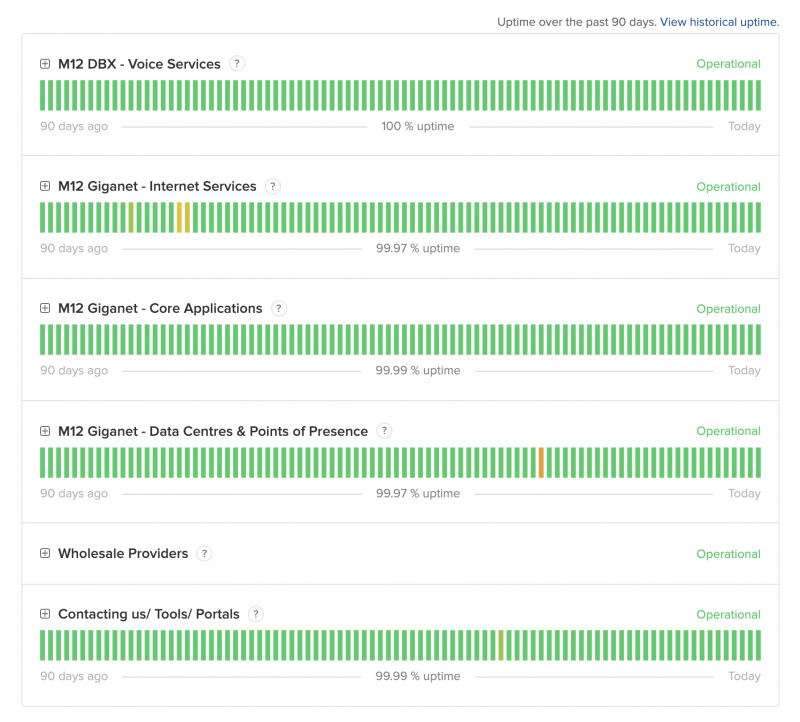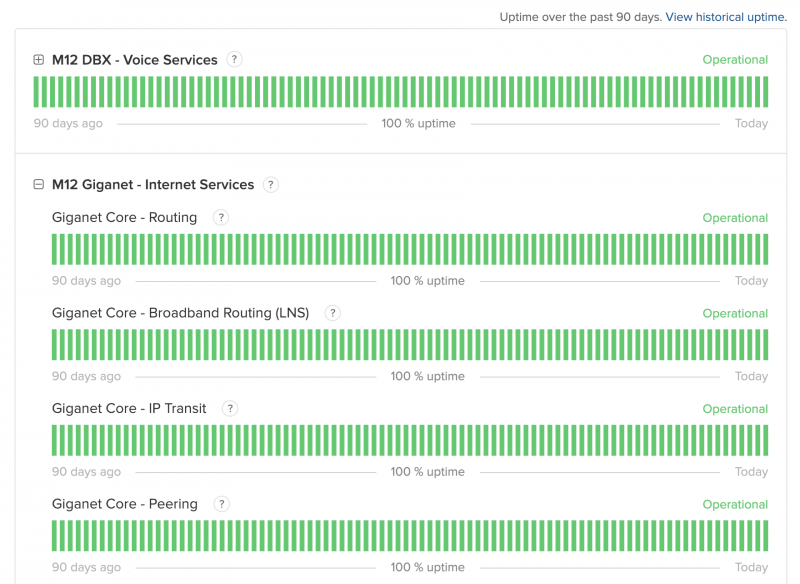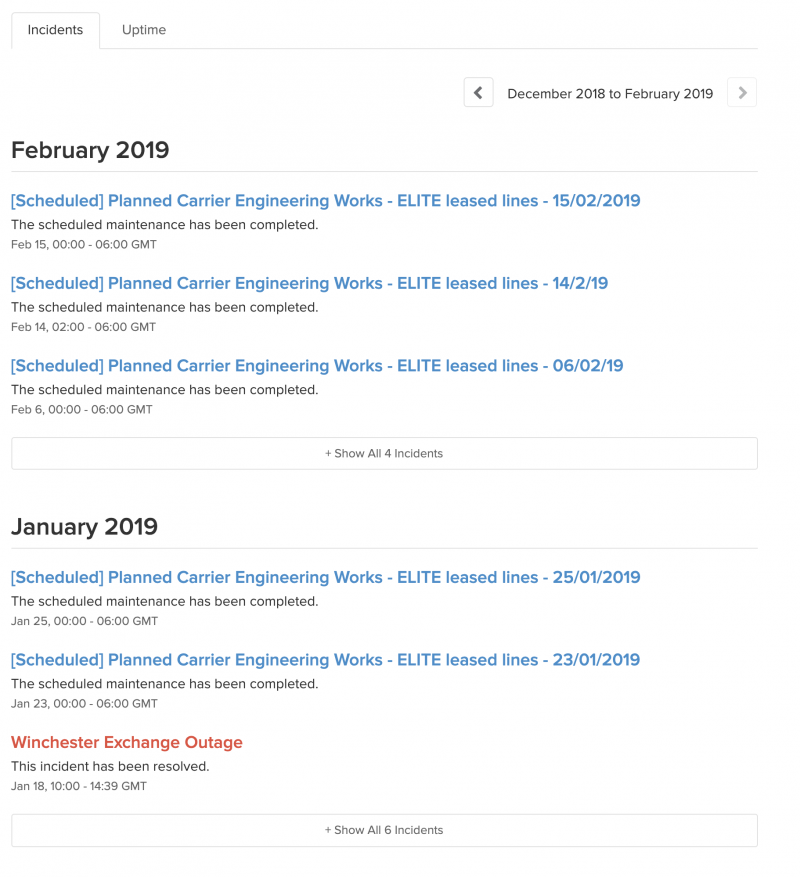“At Giganet, transparency is one of our core values. Our mission is to deliver premium business communication & connectivity services securely and reliably, and on this page you will find details on how we’re doing.”
This paragraph begins our Network Status Page, and it’s more true that you may first may come to expect from a telecoms provider/ISP. Giganet you will find out is not like most other providers.
Network Status Page Features
- Our Network Status Page (Giganet Status Page Status) is not hosted on our network or infrastructure, so in the unlikely event of a catastrophic problem with our network, our Network Status Page will continue to be accessible. In the event our DNS provider suffers an outage, you can also access it via Giganet Status Page Status as a backup link. We recommend customers bookmark these URLs.
- Our Network Status Page is heavily integrated into our realtime networking monitoring systems such as NetShield and remote third party systems too. If they detect an outage, they send an API call to our Network Status Page independent of a human touch 24x7x365. No waiting for an on-call engineer to finally get around to advising customers or forgetting to update the Network Status Page in the event of a major service outage.
- Our main Giganet website features a banner in case there are any known issues affecting the network (maintenance, outages or degradation). No more will customers have to fish around trying to find out what’s going on, as the banner appears at the top of every page on our website if there’s a known problem or network maintenance occurring, and there’s a brief description of the incident, and a link to our Network Status Page.
- Maintenance affecting significant quantities of customers, or core systems is pre-planned and advised on our Network Status Page.
- Customers can subscribe to receive E-mail, SMS, Twitter, RSS or Webhook alerts for all future incidents and pre-planned maintenance. Any new incidents as well as updates can notify customers via these communication methods.
- Our Network Status Page is accessible to anyone. You don’t have to login or be a customer to view it.
- You can see all historic incidents, maintenance and problems. Check out how we’re doing from the past history.
We run our own network
We say this a lot to new prospects, as this single fact is probably one of the most important factors on “Why Giganet” and why not just some other reseller of connectivity services (that probably doesn’t run their own network).
By running our own network rather than reselling (using someone else’s network and adding a margin to a price), we have a lot more control, visibility, scope for innovation that our competitors do. This helps us provision circuits faster; deal with issues more promptly; understand the root cause of problems more speedily; provide faster responses to customers without involving many middlemen. Our staff are also a lot more highly trained and briefed on the inner-workings of connectivity, provisioning and deciphering the sometimes complex processes and specifications involved.
With regards to how this relates to our Network Status Page, we can therefore provide as much information to our customers as we would like if we were the customers. We can also API integrate it to our network monitoring tools. Can other providers offer this who don’t run their own network?
Lots of Information; Transparency to the Core
At the top of our Network Status Page, we immediately report how we’re doing. In the case of the below screen shot take on 14th February, we were doing well!
If you then scroll down further, we expose 35 separate components which each show a 90 day historic status. If you expand the component groups out, you can then hover over each line to understand any past incidents at a glance. In the below example one of our leased line carriers experienced a mass service outage which affected some of our customers as well as many others.
Realtime zero-touch API Integration
Our Network Status Page is heavily integrated into our realtime live network monitoring tools that are currently probing our network more than 2,516,940 times per day (at the time of publication). This number is only increasing as we add more customers, services and core network devices.
What this means is that many of our “components” shown are live integrated into our NetShield networking monitoring tools as well as third party external monitoring systems. In the event that one or more of the systems detect an outage, an API call immediately notifies our Network Status Page advising customers immediately that there’s an issue. This means that no matter if it’s Christmas Day at 0200hrs or a busy working day, customers can instantly see whether an issue they are experiencing is part of a wider incident that we’re already working on. This automation works for most common types of issues that can be automated, but some issues, especially partial outages, degraded service need a human touch to prevent false-positive alerts from being notified.
The same systems that update and notify our Network Status Page are those that notify our on-call duty NOC engineers, and then escalate to other NOC engineers and managers if issues are not investigated in a timely manner.
Historic reporting; Check how we’re doing
Often we’re asked by customers “how reliable is your network”, “when did you last have an incident”?
Well, anyone in the world can now see this via our historic reports on our Network Status Page!
We keep all historic information, whether this is maintenance notifications or service-affecting incidents.
We share our Network Status Page with our other brands – M12 Solutions & DBX
Giganet as you probably know is a brand name of established M12 Solutions Ltd. We’re in the same office as M12, and many of the same team that help out at M12 are also involved in Giganet.
We make no secret of the desire that an M12 Solutions phone system customer should also be a Giganet customer, so we have a consolidated Network Status Page which reveals information about M12, Giganet and DBX services.
If you are an exclusive Giganet customer therefore, you may see notifications and components relating to services, brand names that pertain to our other brands and services. Don’t worry – we have attempted to keep the naming convention simple to interpret what’s Giganet and what’s not. So it’s clear what pertains to your service and what doesn’t. Of course, if it’s not clear, please get in touch, your feedback is very helpful.
Important considerations
As much as we’d like to end this blog post here, it would not be in spirit to end without a quick few points about our Network Status Page, and specifically what it doesn’t report. This you could describe as being the small print!
- We don’t report incidents affecting individual customers.
- For instance if one customer’s Internet connection failed, we’d support this via a dedicated support ticket, and wouldn’t mass notify all other customers or advice this on our public Network Status Page. It’s a little impractical for that! A customer’s circuit may have gone down due to a local power cut, or that they have decided to unplug the router during maintenance.
- We don’t report minor issues that are quickly resolved.
- By minor, we mean those that don’t affect more than 5% of our customers for more than five minutes of consecutive time. Our automated API integrations also don’t trigger unless an incident has been open for at least 5 minutes.
- Notifications can’t be filtered to specific components:
- Sadly, although there is the means to register for E-mail, SMS, Webhook, Twitter or RSS updates to future maintenance and incidents, there is currently no way to filter this to just be against specific Giganet services. It’s all or nothing. This functionality is available with our Network Status Page provider (statuspage.io), however they would charge us over 400% more to have this premium, so we have passed at this time. So please be aware that if you do subscribe to updates, you may find you receive notifications for components and incidents that you don’t need.
However what we do include:
- Mass service outages
- Maintenance events (currently we use it to advice of leased line maintenance event even if this affects 1 customer – however we’re reviewing this)
- Degradation of service events
- Outages or incidents affecting a substantial number of customers
Final comments
I trust that this blog article has provided some added reassurance and value in why working with Giganet for your business or home connectivity is a worthwhile endeavour. We take pride in delivering high-quality, very-reliable connections, and deliver the kind of service that we’d like to receive ourselves.
Matthew Skipsey, Technical Director






